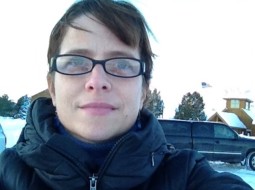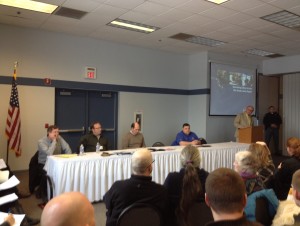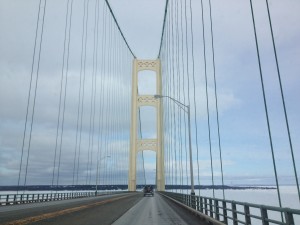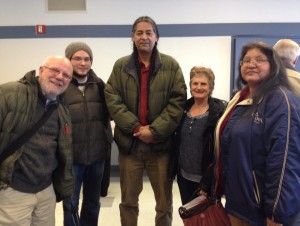Want more? Here are the transcripts of the clips from the February 5 Enbridge meeting with Mackinac County officials and the public regarding the expansion of the Line 5 oil pipeline that is, in part, submerged underwater at the Straits of Mackinac in the Great Lakes.
(RUSH TRANSCRIPT AND STATEMENTS SIC)
1. Enbridge says 5,500 barrels (231,000 gallons) of light crude oil could leak into the Great Lakes.
[soundcloud id=’136703886′ color=’#091571′]One of our residents would like to know, if there is a, um, break, uh, leak, in that 3 minute period from a 20 inch line at 300 pounds per second, what are we looking at, how much oil or volume would be lost to the on site?
Um, you know, I’m going to be completely honest, we talked about how to address this question, and the bottom line is we can speculate all day on worst case scenarios, what I can tell you, and I’ve tried to show you are all of the different safety mechanisms we have in place to ensure that hopefully we don’t have any incidents, but if we do, we work with our Osrow, and the Coast Guard, and all these other places to ensure that we contain it as quickly as possible, and return it to, um, return it back to the state in which it was. And, there’s more questions, you know, related to , um, who is going to pay for it, and of course we do assume that responsibility, um. What materials do you have in the straits? We talked about that. We have stuff on both ends of the straits, with boom, and our people that live and work here. Um, this a an um, I found this kind of interesting: are you planning for the Madrid earthquake? I can tell you that, um, not necessarily Enbridge, nor osrow =, but i can tell you from my past life that the Madrid earthquake is practiced every year by the department of defense, so that’s a homeland security issue and they are dealing with it. (huh?–crowd.)
Simple math problem about the oil spill–crowd
Compensations to businesses would be the same to county and private residents.
Sorry, you didn’t exactly answer my question with quantity. And, surely you know how much is flowing through just like if i spill a 2 cup, uh pale of water i know how much spilled. so, if there was a breach, what would be the release, because you know the quantity right?
Blake: Well, ok, we’d call that a worst case discharge.
Repeat the question!
Jackie: the question is how much is oil is in the pipeline between the two places in which we can isolate it
After the two minute shutdown
After?
There’s 3 minutes before you totally shut down, you said that earlier. So let’s take the worst scenario of 3 minutes of oil flowing at 100%. Like you said, that’s a simple math problem.
Yeah, that’s a simple math problem. Ok, uh, it’s uh, like, without the automatic shutoff system, it was like 15000 barrels, and then when we installed the automatic shutoff system, that cut it down to like 5,500 barrels, but it’s at a pressure, like i showed you, the pressure is like say 150 psi, or less, and i imagine if those valves shut, it’s going to be less, because they wouldn’t shut unless it was less. And we’ve talked about this, so, we have to give them a figure, and it’s on volume, so the very worst case, and it’s very unlikely, is 5,500 barrels. But, you know, one thing that was interesting, some of our engineers were saying, that the water pressure at the bottom of the straits is almost that much, so. not like we are actually going to open and it up and find out what happens, but there’s a good chance that there’s gonna be water going in at one point and holding the oil in. and the oil wants to float up, and it goes down like this. So I really doubt that even close to even a percentage of that would even leak in a scenario.
2. “Extremely conservative” estimate says 25 square miles could be covered.
[soundcloud id=’134804334′ color=’#091571′]So, the first one, given the shutdown response stated, what is the volume of discharge during the time frame stated? That was answered right? Ok, what is the surface area that would result? 5,500 barrels? I’m sorry, I don’t have this exact calculation ready for you, but if anybody needs it, but if anybody needs the exact number, uh, predictive number, we can talk about it, but it’s substantial, very substantial, a figure, and I’m probably very low estimating it, 25 square miles, to figure something like that.
3. In the winter, “Mother Nature will dictate.”
[soundcloud id=’134804343′ color=’#091571′]Next question: May Day, May Day May Day, it’s January 21, 2014, -18, -40 below wind chill, ice is 4 feet htick, oil leak alarms start sounding at 3 locations under the Straits of Mackinac. What are you, Enbridge, and the US Coast Guard going to do about it?
How soon will you have the critical response personal on site, and time to stop the leak. We’ve talked a lot about winter operations, and it should be very clear to everyone that it is a much more difficult type of approach. Now, from a response perspective, we have two ways to access oil under the ice. If it’s thick enough, we can walk out and start drilling holes to get to it. So if this oil spill of one of these 3 leaks that is proposed here, occurs near shore, then we’re going to go out from shore and start doing that. How quick can that happen? First boots on the ground, our first partner companyy is here in St. Ignace, Mackinac Environmental, that provides some assessment, then we start rolling personnel in. And equipment in. As we saw in my slide, we have a 6 hour mainframe model, and a 12 hour time frame model. Now, we need to put a lot of boots on the ground to do that, and to give you an idea of what i would conceive of an operation like that, we’re talking about 100’s of people having to be mobilized in 6-12 hours, so we’re prepared in our planning standards to achieve those kinds of concepts, but to answer the question, in the winter, mother nature will dictate, we need those kinds of resources, and it will complicate it that way, that’s the reality of it.
4. Question: Are there any plans to pipe tar sands through this pipeline?
Answer: “There are no plans to pump what’s known as heavy crude, and sometimes called tar sands, through that pipeline.”
Are there any plans to pipe tar sands through this pipeline? As I said earlier, um, Line 5 is a light crude, um, pipeline, there are no plans to, um, pump what’s know as heavy crudes, and sometimes called tar sands through that pipeline. There are no plans to pump, um, heavy crude through Line 5.
5. Question: What procedure does Enbridge have to follow if they change their mind and want to start shipping tar sands?
Answer: “It’s complicated, let me come back to that.” She didn’t.
If you decide at some point to change what you…to pipe tar sands oil through the straits, what procedure do you have to follow? I’m going to come back to that one because..it’s complicated. Let me come back to that one.
There was a question that she was asked that she said she would defer. I’d like to hear the answer to that question. “She’s ended answering the questions” She deferred that question, she said she would answer it!
6. Line 5 currently pipes low density crude oil and natural gas liquids in 10,000 barrel batches.
[soundcloud id=’134804328′ color=’#091571′]Blake Olson – Enbridge Engineer: “Mixtures of petroleum, does that flow through this pipe? Well, It’s light density crude oil and natural gas liquids, that’s what flows through the pipe. Uh, they’re batched in like 10,000 barrel batches, and they have different names by who produced them and from where they came, but they are basically the lighter density oil. Line 5 is designed for piping that type of fluid. If we were to switch to heavy crude, we would have to change a lot of things on the pipeline, including all the pumps and whatnot. That’s all, I guess, I can explain, petroleum dense…light density oil and natural gas liquids, which is raw propane and butane.”
7. Most of the product comes from the Bakken Shale in North Dakota.
[soundcloud id=’136693110′ color=’#091571′]Where does that product come from? Our light crude comes mostly from the Bakken.
8. All oil floats, but some oil floats better than other oil.
[soundcloud id=’134804332′ color=’#091571′]The question here was: Does all oil float? Well, all the oil has, you know, a density less than water, so it should float. Uh, The, uh, light crude oil has lower density than the heavier crude oil service, and this is the light oil, so, uh, it floats better on line 5 than, it, uh, maybe on the heavier oil lines. But it all floats.
9. All questions that mention the Kalamazoo River spill were rejected.
[soundcloud id=’134804331′ color=’#091571′]There were a lot of questions here about Kalamazoo. Line 5 and line 6 are two different lines that do different things I’m not going to get into discussing Kalamazoo here today. We’ve learned a lot from it. “It’s still not cleaned up” We’re in the process of finishing that.
10. Enbridge inspects for dents, cracks, and wall thickness. Line 5 under the Straits has no dents and good wall thickness.
[soundcloud id=’134804341′ color=’#091571′]The monitoring efforts and inline inspection: the inline inspection tools in our sophisticated electronic vehicles move inside the pipe along with the oil, they obtain detailed measurements in the pipeline condition, they’re look at, these are three of the different types: they look at corrosion or wall thickness of the pipe, that’s how they can tell that the pipe is still the same thickness. They also look for dents in the pipe. And they look for, uh, cracks in the pipe. And the, uh, data, at the end of last year, the new data shows that the wall thickness is still almost an inch thick, and it also shows that there’s no dents on any of the straits.
11. In 2012, Enbridge documented hundreds of “abnormalities or cracked features” on Line 5.
[soundcloud id=’134804342′ color=’#091571′]Based on Enbridge 2012 documents, hundreds of abnormalities or cracked features have been documented on line 5, and these abnormalities, they say, are similar to 6b which ruptured and caused that largest inland heavy sands spill. And uh, so, what, specific measures is Enbridge taking to remediate these abnormalities on the pipeline through the straits? Well, that’s what I was talking about, that;s what we’re doing; we beefed up the whole division that works on those, and we keep, just, and then, of course the straits piping, we’re running the tools, and we’re not finding any indications. So, uh, it’s because, that’s the thickest pipe we have in our whole system in all of North America. They just over-designed the whole straits crossing, that special seamless pipe.
12. “They don’t build it like this anymore.”
[soundcloud id=’134804335′ color=’#091571′]Hello, thank you for coming. Ok, Enbridge, uh, strives for a safe delivery of liquid petroleum, and transport. The seamless steel pipe is a very robust design, it’s, you, we really have to give credit to the engineers that designed it, it’s really built to last. It’s really one of those stories where “they don’t build it like this anymore”. The, uh, pipeline is nearly 1 inch thick of steel, the two 20-inch lines.
13. “The seamless pipeline under the straits is in fact seamless.”
[soundcloud id=’134804336′ color=’#091571′]Um, there’s a question about seams, the pipeline, the seamless pipeline under the straits is in fact seamless.
14. The pipeline is welded every 40 feet. The seamlessness of the pipeline is referring to the side-seam.
[soundcloud id=’134804338′ color=’#091571′]Ok, just a clarification probably: how is a pipeline 5 miles long created without any seams. And, as you can see on the pipeline, there’s a different process to make a seamless pipe than there is to make a regular piece of pipeline. A regular piece of pipeline you take a flat piece of metal, it get’s rolled and folded, it gets welded, kind of like your pantleg, you’ve got a seam going down your pant leg, and that’s the side seam. As far as that piece of pipe it’s more continuous, there’s a whole different process that produces a seamless pipe. Now, there are joints in the pipe, so to be clear on that, the pipe did come out in 40 foot sections, so they are welded every 40 feet along there, there’s a butt welded to a joint, but there’s not a seam going all the way down there.
15. “There were no regulations that had to be met when that line was built,” but Enbridge looked it over in 2004 and concluded that Line 5 to par.
[soundcloud id=’134804340′ color=’#091571′]A question that is a 2 part one: if teh pipeline were to be installed today, how would it differ from the way it was designed originally? Would it be done differently to meet design requirements? For example would a double walled pipe be required?
Just a little history, I used to work for the Minnesota office of pipeline safety, so I was trained with PHMSA, and so I got a pretty good background on the requirements. This pipeline going across the straits was built before PHMSA existed, so there were no regulations that had to be met when that pipeline was built. Now that said, Enbridge went back in 2004, went back through all the orignial design calculations just to double check how it was built and if it was still built to an acceptable standard today, and it was far in excess of what PHMSA requires.
16. People got angry that Enbridge didn’t answer all their questions at a public meeting about Line 5.
[soundcloud id=’134804344′ color=’#091571′]Um, we’ve exceeded the time that the commission has allowed us, we hope we’ve answered your questions. (Audience angry yelling) I realize that. I’m sorry, this is going to end, if you want to have your question answered after this session by Enbridge employees, uh…we could go on for hours but uh, this is what was sessioned…(audience yelling)









